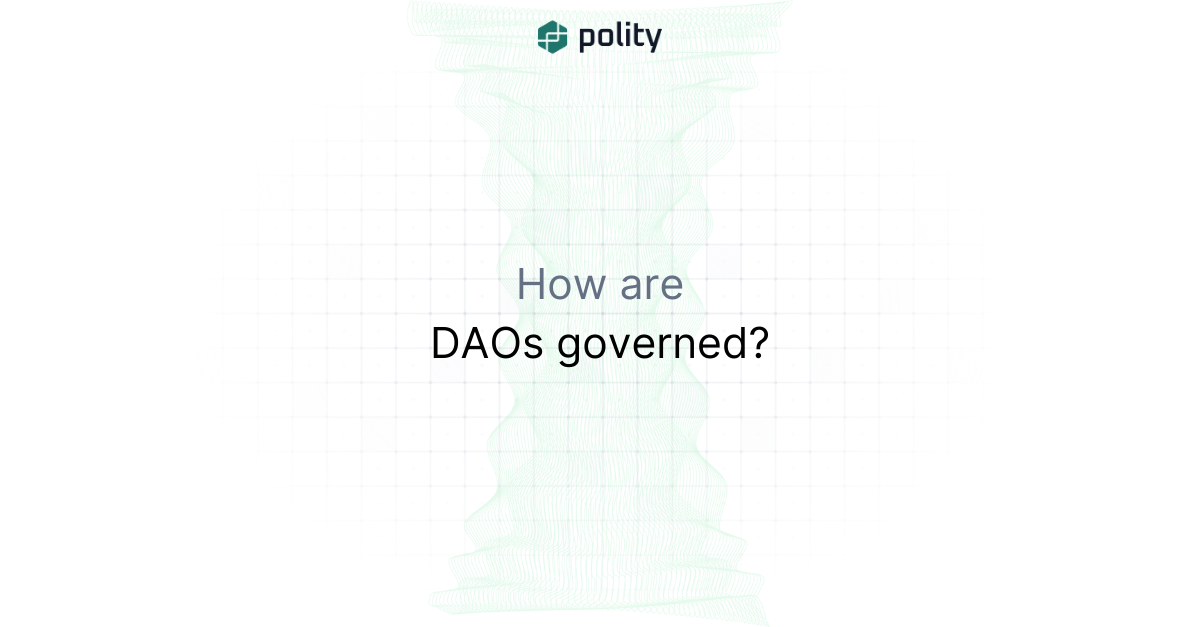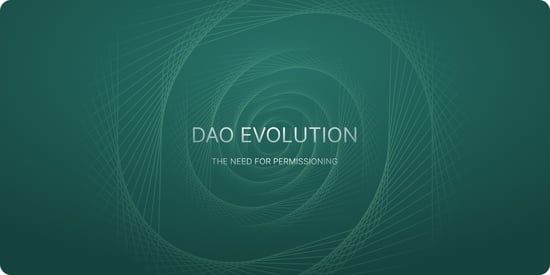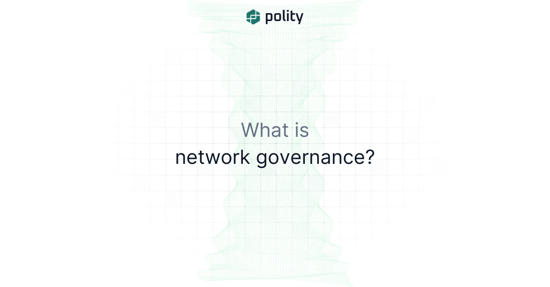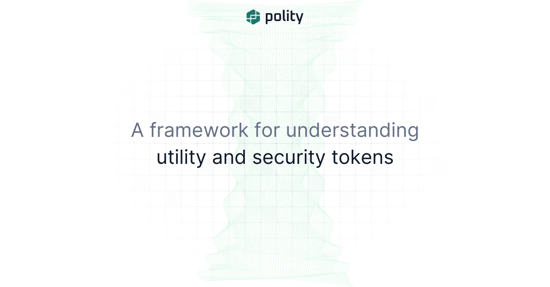Decentralised Autonomous Organisations, or DAOs, are an evolution of network organisations enabled by the DLT technology.
The horizontal relationships between members and the network they form in a DAO are powered by governance tokens. These help drive decision-making and value creation. Smart contracts facilitate these processes, reducing operating inefficiencies and supervisory costs.
Coordinating this network is essential for organisational success, meaning DAOs must implement robust and transparent governance practices.
Given the nascent stage of DAO development, there is no one-size-fits-all governance approach, so this article will explore the variety of DAO governance frameworks and techniques.
What is the DAO governance process?
Governance is the process of idea generation, decision-making and implementation.
DAOs, as a novel form of a network organisation, must develop their own robust governance standards. As we have explored in the previous articles, effective governance is essential for organisational success. DAO governance builds on corporate and network governance practices and the DLT technology to compete effectively with other DAOs and centralised organisations.
Though the specifics of DAO governance vary widely, it typically revolves around community-driven initiatives and voting.
Initiatives are member-suggested actions or modifications such as protocol changes, project funding, or alternative technological or structural solutions, etc.
These initiatives are typically presented to DAOs for consideration and approval as formal proposals. A given proposal describes the initiative, outlines its net benefits for the DAO community and makes specific recommendations. In DAOs, just as in all other organisational forms, the governance process generally consists of proposal creation, review, voting, and implementation:
Proposal creation in DAOs
Any member of a DAO can develop initiatives about anything the member believes to be relevant to the DAO.
These proposals may include changes to the DAO's rules, allocation of resources, strategic or tactical decisions, personnel engagement or remuneration matters. The proposing member is responsible for clearly and concisely outlining the rationale for an initiative and submitting it to the DAO through a clear pre-agreed procedure and channels.
Proposal review in DAOs
Once submitted, the community reviews the proposal.
This can involve discussions, debates, and clarifications about the specifics, allowing members to understand the initiative's implications and ask any questions they may have. Participation of other members in the review is normally not mandatory but may be rewarded in a certain form, subject to specific procedures adopted by that DAO. Such rewards facilitate higher community involvement and diversity of views.
Voting in DAOs
After the review period, the community votes on the proposal.
The specifics of the voting process can vary between different DAOs, occurring both on-chain and off-chain. Some DAOs use a simple majority rule, while others might require a supermajority. Others may use more complex voting mechanisms, such as delegated or liquid democracy, which we will explore below.
Voting power is typically proportional to the number of governance tokens a member holds, although some DAOs are exploring alternatives such as quadratic voting, also explored below.
Proposal implementation in DAOs
If the community approves the proposal, implementation is the step step.
This process may require assets and/or resource allocation. It may also call for review and adjustment of other project elements. Depending on the nature of the proposal, its execution is either automated through smart contracts on-chain or implemented by the community off-chain.
What is on-chain and off-chain governance in DAOs?
Voting, as mentioned earlier, is the second core aspect of DAO governance.
Votes allow the community to express their collective and individual opinions. These votes are fundamental to decentralised decision-making. DAOs tend to make these decisions either on-chain or off-chain, with these terms referring to the mechanisms and processes of a given DAO.
Most DAOs leverage a combination of on-chain and off-chain governance to balance flexibility, participation, and transparency.
What is on-chain governance?
On-chain governance is an automated DAO governance process powered by governance tokens and smart contracts containing protocol-specific governance frameworks.
All governance activity, from proposals to votes, is immutably recorded in the blockchain ledger. While on-chain governance ensures transparency, it is limited by what can be (or has been) programmed into the governance smart contracts. The immutability of smart contracts also means it is difficult, if not impossible, to update governance frameworks in the future, potentially limiting future organisational success.
Voter apathy is common, as most token holders are passive and do not participate in on-chain votes.
The centralisation of tokens to a few significant holders also often impacts governance viability.
What is off-chain governance?
Off-chain governance refers to governance that happens outside of the blockchain protocol through organisations and processes in the real world.
In off-chain governance, groups of individuals execute their governance rights through communicating and voting via email, forums, or otherwise. Community members may discuss and find consensus off-chain, with the results then implemented on-chain. Off-chain governance can evolve and adapt faster than on-chain solutions, allowing DAOs to engage the broader community for feedback and buy-in effectively.
However, off-chain governance lacks the transparency of on-chain votes and rules and tends to move much slower.
There is also a greater risk of power becoming concentrated in a small group of individuals.
A typical DAO starts with mastering its governance procedures off-chain. It then gradually develops and implements technical solutions, increasing the proportion of governance practices moved to on-chain.
How does voting work in DAOs?
DAOs can adopt a variety of voting mechanisms to enable decision-making.
Many DAOs operate using the direct democracy model, where one token equals one vote. Other DAOs are exploring and implementing alternatives such as delegated democracy, quadratic voting, and liquid democracy.
Direct democracy in DAOs
Direct democracy is a form of governance where the entire eligible population votes on all decisions.
Each individual has an equal vote on each issue, and the majority decision is binding. In the context of DAOs, direct democracy means that every token holder can vote on proposals directly rather than delegating their voting power to representatives. This voting system is the basis of the one token = one vote model, which is sometimes derailed by those with large holdings
Delegated democracy in DAOs
Delegated democracy, or representative democracy, is a form of governance where individuals elect representatives to make decisions on their behalf.
In DAOs, token holders can delegate voting power to delegates or representatives. This allows many token holders to still have a voice without participating directly in every vote. While delegation can increase voter participation, it can lead to centralised governance if most token holders delegate to a few significant representatives.
These representatives then have disproportionate influence over DAO decisions.
The emergence of voter coalitions, such as those in MakerDAO, can signal governance centralisation in DAOs, and these coalitions can have a complicated influence on the protocols governed by the DAO.
Quadratic voting in DAOs
In quadratic voting, participants can cast multiple votes on a proposal, but the cost of casting n votes is not linear but quadratic.
Each additional vote costs more than the previous one, meaning more votes for a given proposal demonstrates how strongly in favour of a proposal a member is, rather than just whether they are in favour of it or against it. In the context of DAOs, members could "purchase" votes for a given proposal using their tokens, with greater token allocations demonstrating conviction.
Liquid democracy in DAOs
Liquid democracy is a form of democratic governance where voting power is fluid and can be delegated to others.
This system allows individuals to vote directly on issues or delegate their voting power to a trusted party. In the context of DAOs, token holders can participate directly in governance decisions or delegate their voting power to representative parties if they lack time or expertise. Liquid democracy also allows for more nuanced voting, as voters can delegate their vote on a per-issue basis to proxies they trust for that particular issue.
Discover the future of DAO governance with Polity Network.
As the field of DAOs continues to evolve, so will their governance mechanisms.
At Polity Network, we are driving that evolution. By combining traditional enterprise with decentralised governance, we’re creating something new: federated governance. Federated governance captures the best of both worlds, allowing us to innovate in our governance framework and business model.
To learn more about Polity Network and federated governance, subscribe to this publication and visit our website.
References
1. Feichtinger, Rainer, Robin Fritsch, Yann Vonlanthen, and Roger Wattenhofer. "The Hidden Shortcomings of (D)AOs -- An Empirical Study of On-Chain Governance." arXiv preprint arXiv:2302.12125 (2023).
2. Fritsch, Robin, Marino Müller, and Roger Wattenhofer. "Analyzing Voting Power in Decentralized Governance: Who controls DAOs?" arXiv preprint arXiv:2204.01176 (2023).
3. Sun, Xiaotong, Charalampos Stasinakis, and Georigios Sermpinis. "Decentralization Illusion in Decentralized Finance: Evidence from tokenized voting in MakerDAO polls." arXiv preprint arXiv:2203.16612 (2022).
4. Sun, Xiaotong, Xi Chen, Charalampos Stasinakis, and Georgios Sermpinis. "Voter Coalitions and democracy in Decentralized Finance: Evidence from MakerDAO." arXiv preprint arXiv:2210.11203 (2022).
5. Barontini, Andrea. "Quadratic Payments with constrained probabilities." arXiv preprint arXiv:2104.12700 (2021).
6. Gölz, Paul, Anson Kahng, Simon Mackenzie, and Ariel D. Procaccia. "The Fluid Mechanics of Liquid Democracy." arXiv preprint arXiv:1808.01906 (2018).





